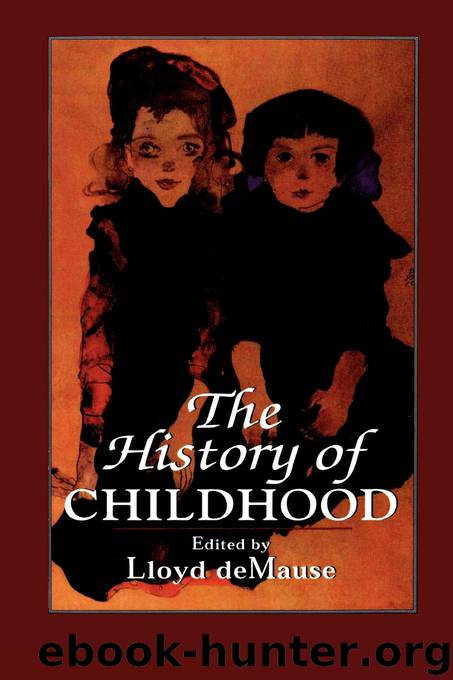The History of Childhood by Lloyd Demause

Author:Lloyd Demause
Language: eng
Format: mobi
Tags: Non-Fiction, Child Abuse, Psychology, History
ISBN: 9781568215518
Publisher: Jason Aronson, Inc.
Published: 1995-06-01T23:00:00+00:00
CHAPTER 5
The Child as Beginning and End:1 Fifteenth and Sixteenth Century English Childhood
M. J. TUCKER
“The child whom the father loves most dear he does punish most tenderly in fear.”
The medieval idea that children were not terribly important persisted into the fifteenth and sixteenth centuries. Nowhere is this attitude more evident than in the household proverbs on the lips of princes, parsons, and poets. Children were equated to senile old men, foolish women, and doddering drunks.2 One proverb said: “For children and women naturally are hard to keep counsel of that thing a man would have kept secret (1525).”3 To the sixteenth century children were no better than churls, aged men, or women, for “all is lost that one gives to four sorts of people: the first is a villain or churl, for again you shall him prove unkind, the second a child, for his forgetful mind expells kindness, the third a man in age, the fourth a woman variable as the wind, being of her love unstable and fickle (1509).”4 Even the Pastons in their famous correspondence repeated the old saw that children were about as trustworthy as a broken sword. Their language is picaresque: “A man should not trust on a broken sword, nor on a fool, nor on a child, nor on a wraith, nor on a drunkard (1460).”5 Again: “He is a fool that agrees to the counsel of a child (1533).”6
Constant repetition of such notions must have added to the child’s feeling that it counted for little and that childhood was a state to be endured rather than enjoyed. As parents and others measured them in their early years, hardly a kind word was spoken of them. Some placed them in the same unproductive categories as sad-eyed drunks, jabbering women, and foolish old men. Others said “Who sees a child sees nothing.”7 Such a view is best illustrated in Pynson’s The Kalendar of Shepherdes where the ages of man are divided into twelve six-year periods corresponding to the twelve months of the year. The first period likened to January consists of man’s first six years where he is “without wit, strength or cunning and may do nothing that profits (1506).”8
Before demonstrating that this view was in the process of being changed by new attitudes, let me define the limits of my inquiry. First, children will be considered from birth to age seven, Piaget’s threshold of abstract reasoning. Second, chronologically speaking, the fifteenth and sixteenth centuries will be taken as 1399-1603 because these dates coincide with great dynastic changes in English history. Third, geographically and linguistically speaking, the inquiry will be confined to England; the continent, especially France, will be used only for comparison with England.
The sources used are primarily early printed books which deal with children, education, pediatrics, and parental attitudes.9 The discussion divides naturally into the categories of physical care, education, religion, witchcraft, work and play. One must emphasize, however, before considering physical care, that the men and women of early modern times thought about children, if at all, in hierarchical terms.
Download
This site does not store any files on its server. We only index and link to content provided by other sites. Please contact the content providers to delete copyright contents if any and email us, we'll remove relevant links or contents immediately.
| Child Abuse | Elder Abuse |
| Partner Abuse |
Should I Stay or Should I Go? by Ramani Durvasula(7570)
The Lost Art of Listening by Michael P. Nichols(7411)
The Rosie Project by Graeme Simsion(6200)
Beartown by Fredrik Backman(5603)
We Need to Talk by Celeste Headlee(5547)
Ego Is the Enemy by Ryan Holiday(5297)
Hunger by Roxane Gay(4869)
Suicide Notes by Michael Thomas Ford(4764)
I Love You But I Don't Trust You by Mira Kirshenbaum(3810)
Mummy Knew by Lisa James(3637)
Not a Diet Book by James Smith(3341)
Crazy Is My Superpower by A.J. Mendez Brooks(3332)
Toxic Parents by Susan Forward(3226)
Girl, Wash Your Face by Rachel Hollis(3210)
The Complete Idiot's Guide to Coping With Difficult People by Arlene Uhl(3118)
The Social Psychology of Inequality by Unknown(2941)
Name Book, The: Over 10,000 Names--Their Meanings, Origins, and Spiritual Significance by Astoria Dorothy(2940)
The Hard Questions by Susan Piver(2928)
The Gaslight Effect by Dr. Robin Stern(2739)
